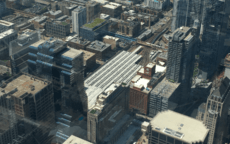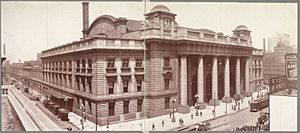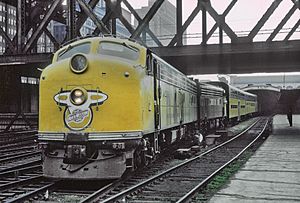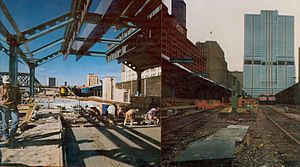Ogilvie Transportation Center facts for kids
The Richard B. Ogilvie Transportation Center (once known as the Chicago and North Western Terminal) is a busy train station in downtown Chicago, Illinois. It's where three Metra commuter train lines end their journeys. These lines bring people from Chicago's northern and western suburbs.
The station is located on the lower floors of the 500 West Madison Street building. This huge building covers two city blocks! It's bordered by Randolph Street and Madison Street, and by Canal Street and Clinton Street. Ogilvie is the second busiest train station in Chicago, right after Chicago Union Station. It's also one of the busiest stations in North America that only serves commuter trains.
Quick facts for kids
|
|||||||||||||||||||||||||||||||||
|---|---|---|---|---|---|---|---|---|---|---|---|---|---|---|---|---|---|---|---|---|---|---|---|---|---|---|---|---|---|---|---|---|---|
 |
|||||||||||||||||||||||||||||||||
| Location | 500 West Madison Street Chicago, Illinois 60661 United States |
||||||||||||||||||||||||||||||||
| Coordinates | 41°52′58″N 87°38′25″W / 41.88269°N 87.64029°W | ||||||||||||||||||||||||||||||||
| Owned by | Union Pacific Railroad, Metra | ||||||||||||||||||||||||||||||||
| Platforms | 8 island platforms | ||||||||||||||||||||||||||||||||
| Tracks | 16 | ||||||||||||||||||||||||||||||||
| Connections | Chicago "L":
|
||||||||||||||||||||||||||||||||
| Construction | |||||||||||||||||||||||||||||||||
| Disabled access | Yes | ||||||||||||||||||||||||||||||||
| Other information | |||||||||||||||||||||||||||||||||
| Fare zone | A | ||||||||||||||||||||||||||||||||
| History | |||||||||||||||||||||||||||||||||
| Opened | 1911–1912 | ||||||||||||||||||||||||||||||||
| Rebuilt | 1984–1987 | ||||||||||||||||||||||||||||||||
| Previous names | Chicago and North Western Terminal/North Western Station (1911–1997) | ||||||||||||||||||||||||||||||||
| Traffic | |||||||||||||||||||||||||||||||||
| Passengers | 106,800 daily (Metra) | ||||||||||||||||||||||||||||||||
| Services | |||||||||||||||||||||||||||||||||
|
|||||||||||||||||||||||||||||||||
|
|||||||||||||||||||||||||||||||||
Contents
History of the Station
The First Station (1911)
The Chicago and North Western Railway built the first Chicago and North Western Terminal in 1911. It replaced their older Wells Street Station across the Chicago River. The new station was designed in a grand style called Renaissance Revival.
To make space for this big new station, an entire factory building had to be moved! The Tyler & Hippach Mirror Company Factory was shifted 168 feet east and 52 feet south. At the time, this was the largest building ever moved.
The station had 16 tracks raised above street level. It also had a huge waiting room with a high, curved ceiling. There were special rooms for travelers, like dressing rooms and a doctor's office. There was even a separate area for people who just commuted to work every day.
In the past, this station was a hub for trains going to cities like Milwaukee and Minneapolis. Famous trains like the 400 series used to leave from here. Until 1955, trains from the Union Pacific Railroad also used this station. These included well-known trains like the Overland Limited and the "City" trains, such as the City of San Francisco.
A New Station Building (1984)
In 1984, the original station building was taken down. It was replaced with a modern, 42-story glass and steel building. This new building was finished in 1987. Even while the new building was being constructed, train services continued with very few delays.
Big Upgrades (1991)
In 1991, Metra bought the train shed part of the station. They decided to give it a major makeover to make it better for modern commuters. This was a huge project!
The work included replacing all 16 tracks, which served 200 trains every day. They also fixed a lot of the steel structure and built a new steel roof. The outside of the building was repaired, and new electrical and plumbing systems were installed. A new walkway for people was also built. This big renovation took four years and cost $138 million.
The station was renamed the Ogilvie Transportation Center in 1997. This happened two years after the Chicago and North Western Railway joined with the Union Pacific Railroad. The station was named after Richard B. Ogilvie. He was a former governor of Illinois who helped create Metra's parent agency. Many people who have lived in Chicago for a long time still call it "North Western Station."
Platforms and Tracks

The Ogilvie station has 16 tracks and eight island platforms. Each island platform serves two tracks. The platforms on the west side of the station are longer than those on the east side.
Trains for the West Line usually leave from the western platforms. Northwest Line trains use the middle tracks, and North Line trains use the eastern tracks. This setup helps trains move smoothly without blocking other tracks. It allows many trains to arrive and depart at the same time.
Just north of the station, the 16 tracks narrow down to six. These six tracks then split into two main lines a bit further away. One line goes west, and the other goes northwest.
Train Services
The Richard B. Ogilvie Transportation Center is now the main station for Metra's three Union Pacific District lines. These are the Union Pacific/North Line, the Union Pacific/Northwest Line, and the Union Pacific/West Line. These lines provide regular commuter train service.
More than 106,000 people ride Metra trains from Ogilvie Transportation Center every day!
Daily Passengers
| Rank | Route | Daily Passengers (weekday) |
|---|---|---|
| 1 | UP-N
to Kenosha |
41,000 |
| 2 | UP-NW | 38,600 |
| 3 | UP-W
to Elburn |
27,200 |
Bus and 'L' Connections
It's easy to connect to other transportation from Ogilvie. You can catch CTA Buses on Madison Street or Washington Boulevard. There's also a walkway from the train platforms that leads to bus stops.
Ogilvie also connects to Chicago's "L" train system. The station is right next to the Clinton station (Green and Pink Lines). The Washington/Wells station (Brown, Orange, Pink, and Purple Lines) is also just three blocks away.
CTA Buses
- J14 Jeffery Jump
- 19 United Center Express
- 56 Milwaukee
- 60 Blue Island/26th (Owl Service)
- 120 Ogilvie/Streeterville Express
- 124 Navy Pier
- 125 Water Tower Express
- 126 Jackson
- 128 Soldier Field Express
- 130 Museum Campus
- 157 Streeterville/Taylor
- 192 University of Chicago Hospitals Express
Images for kids







